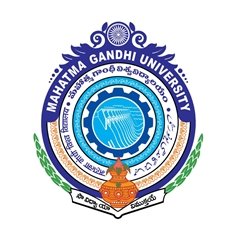The Emblem of the University is designed by N. Sharat Babu. It is a round logo consisting of Dharma Chakra with peacock feathers on top and Nagarjuna Sagar Dam in the middle. It is skirted by a Wheel and Purnakumbham with two corns on the left and the right. The name of the University figures in four languages and also a Sanskrit inscription at the bottom, "Saa Vidyaa Ya Vimukthaye"
At the top of the Logo is Ashoka's Dharma Chakra which stands for maintenance of Dharma impliying cosmic order, moral principles and spiritual enlightenment.

The Peacocks perched on either side of the wheel are a representation of the national bird. At the centre of the logo are cascades of water gushing out of the Nagarjuna Sagar reservoir located at Nandikonda hills of Nalgonda District.
The reservoir irrigates several lakhs of acres of lands in the districts of Nalgonda, Khammam, Krishna and Guntur. It is a symbol of national pride and a place of tourist importance for visitors from home and abroad.
The water reservoir is skirted by a wheel on all sides representing industry. The university seeks to establish liaison between the industry and itself in its march towards industrial growth.
The colorful Kalasham (Purnakumbham) in the logo has local relevance, historical significance and religious sanctity. The Kalasham is an auspicious icon and signifies perfection and knowledge. The Kalasham is a relic of the ancestry preserved in the fort of Deverakonda in Nalgonda District.
At the bottom of the Kalasham is a book representing knowledge and learning, the very essence and soul of a University.
At the bottom of the logo are two corns symbolizing greenery, granary and fertility.
The Sanskrit inscription, "Saa Vidya Ya Vimukthaye" spreads the divine message that "good education leads to the liberation of minds from evils and inculcates virtues".
Nomenclature of the University in four languages - English, Telugu, Hindi and Urdu is a symbiosis of the international language (English) with the local and national languages.
Finally, the university named after the Father of the Nation, Mahatma Gandhi, anticipates the spirit of tolerance and non-violence among the students as well as the faculty.